Is Chinese Tea Good for You
Shop our Pu Erh Tea collections!
Chinese tea offers a myriad of benefits that enhance your overall well-being.
Antioxidant Properties
Chinese teas like green tea and oolong tea are rich in antioxidants. These compounds help reduce oxidative stress in the body, promoting cellular health.
Bestsellers

2022 Pu-Erh Tea Sample Box (Free Shipping)

2022 Yi Pin Chen Sheng Raw Pu-erh Tea Sample Box

2022 Lao Ban Zhang Raw Pu-erh Tea

2022 Na Ka Raw Pu-erh Tea

2023 Ban Zhang Yin Xiang Raw Pu-erh Tea

2017 Rong Pu Ripe Pu-erh Tea
Improved Digestion
Consuming pu-erh tea can aid in digestion. The fermentation process of pu-erh tea produces enzymes that aid in breaking down fats and proteins.
Weight Management
Regularly drinking green tea can support your weight loss goals. It contains catechins, which may increase metabolism and fat oxidation.
Mental Alertness
The caffeine in black tea provides a gentle boost in mental alertness. Drinking black tea can help you stay focused and sharp.
Heart Health
Oolong tea and green tea may contribute to heart health. These teas can help lower cholesterol levels and reduce blood pressure.
Anti-Inflammatory Effects
Tea varieties like white tea have anti-inflammatory properties. These can help to alleviate symptoms of inflammation-related conditions.
Enhanced Immune System
Chinese herbal teas, such as Ginseng Oolong, can strengthen the immune system. Ginseng boosts your body's resistance to illnesses.
Skin Health
Drinking white tea can promote healthy skin. The antioxidants in white tea help to fight free radicals that cause skin aging.
Bone Health
Regular consumption of green tea may improve bone health. Studies suggest that green tea can increase bone mineral density.
Types of Chinese Tea

Chinese tea varies widely in flavors, antioxidants, and health benefits, making it an essential part of Chinese culture. Each type of tea offers unique characteristics and brewing methods, from Green Tea's vibrant flavors to Pu-Erh Tea's fermented richness.
Green Tea
Green Tea is known for its fresh, grassy flavor and high antioxidant content. Popular types include Longjing (Dragon Well) and Biluochun. Green Tea leaves are minimally oxidized, preserving their natural color and nutrients. You can enjoy Green Tea hot or cold, and it’s often praised for its potential benefits, such as weight loss, improved brain function, and reduced risk of certain diseases.
Black Tea
Black Tea, or Hong Cha, is fully oxidized, giving it a bold flavor and dark color. Popular varieties include Keemun and Dian Hong. This tea may support heart health and improve gut bacteria. Rich in caffeine, Black Tea provides a robust taste and is usually enjoyed hot. It’s a common base for flavored teas and blends, including the popular Earl Grey.
Lao Ban Zhang

2024 Lao Ban Zhang Ripe Pu-erh Tea

2022 Lao Ban Zhang Raw Pu-erh Tea

2023 Ding Feng- Lao Ban Zhang Raw Pu-erh Tea (42g)

2024 Xiao Ban Zhang Raw Pu-erh Tea

2020 Lao Ban Zhang Raw Pu-erh Tea 125g
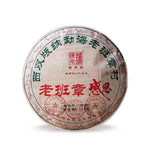
2025 Lao Ban Zhang -Gan En Raw Pu-erh Tea 357g
Oolong Tea
Oolong Tea is partially oxidized, offering a flavor profile between Green and Black Tea. Varieties like Tieguanyin and Da Hong Pao are well-known. This tea is celebrated for its floral and fruity notes, as well as its potential to aid digestion and lower cholesterol. You can steep Oolong Tea multiple times, each infusion revealing a different aspect of its complex taste.
White Tea
White Tea is the least processed, made from young leaves and buds. Varieties such as Bai Mudan (White Peony) and Silver Needle fall in this category. It has a delicate, sweet flavor and contains a high level of catechins, which are known for their antioxidant properties. White Tea may improve skin health and boost the immune system.
Pu-Erh Tea
Pu-Erh Tea is fermented, offering earthy, deep flavors. It comes in Raw (Sheng) and Ripe (Shou) forms. This type is unique as it improves with age, often available as cakes or bricks. Pu-Erh Tea is famous for its potential to reduce cholesterol and assist in weight management. Its complex taste can be an acquired one, favored by tea enthusiasts.
Herbal Tea
Herbal Tea, or Tisane, usually includes medicinal herbs, flowers, and fruits. Varieties such as Chrysanthemum Tea and Ginseng Tea are popular. Unlike other types, Herbal Teas do not contain tea leaves and are naturally caffeine-free. They are often consumed for their health benefits, including calming effects, improved digestion, and support for sleep.
Historical Significance of Chinese Tea
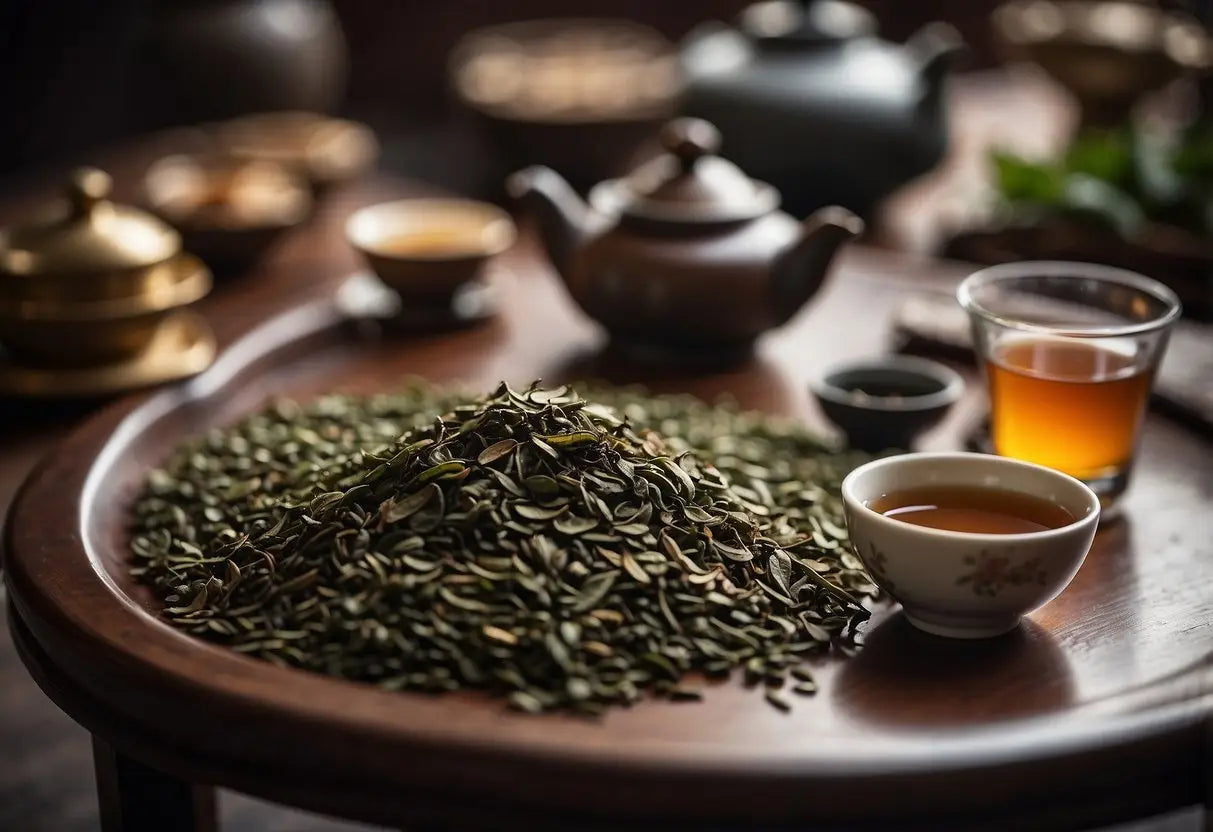
Chinese tea has a history dating back over 4,000 years. According to legend, it was discovered by Emperor Shen Nong in 2737 BCE. As he boiled water under a tree, tea leaves accidentally fell into the pot, creating the first cup of tea.
Tea played a crucial role in Chinese culture and daily life. It became a staple commodity in trade, contributing to the prosperity of the Silk Road. Tea’s influence spread, impacting social rituals and customs.
During the Tang Dynasty (618-907 CE), tea transformed from a medicinal beverage to a daily drink. The Classic of Tea by Lu Yu, written during this period, is considered the first monograph on tea culture.
In the Song Dynasty (960-1279 CE), the art of tea preparation and presentation flourished. Tea competitions, where participants showcased their skills, became popular. The methods of tea cultivation and processing were refined.
In the Yuan Dynasty (1271-1368 CE), tea houses became social hubs. These spaces were not only for drinking tea but also for discussions, performances, and artistic exchanges.
During the Ming Dynasty (1368-1644 CE), loose leaf tea gained popularity, replacing tea bricks. The process of tea making became more sophisticated, leading to the development of various teas like green, black, white, and oolong.
In the 17th century, Chinese tea reached Europe through Dutch traders. Its international appeal grew, becoming an integral part of global tea culture.
You can see the lasting impact of Chinese tea in modern agricultural practices, global trade, and cultural traditions.
Chinese Tea Cultivation and Processing Methods
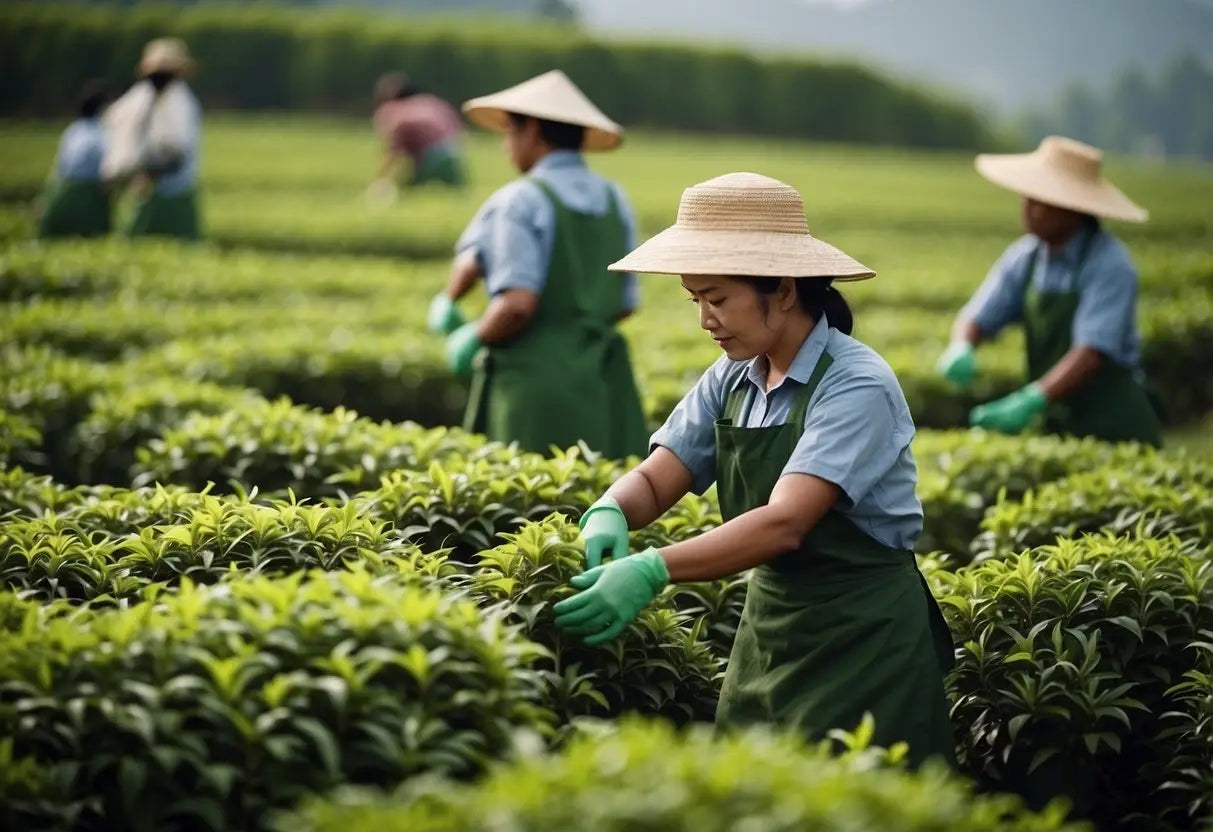
Chinese tea cultivation begins with careful selection of regions known for their unique climates and soil conditions. Areas like Fujian and Yunnan are famed for their tea-growing environments.
Tea plants thrive in well-drained, acidic soils with ample rainfall. Farmers often employ organic and sustainable practices to ensure high-quality harvests.
Processing involves several key steps: plucking, withering, rolling, oxidation, firing, and sorting. Each step varies depending on the type of tea being produced.
Green tea is minimally processed, with withering and firing done quickly to preserve its green color and fresh flavor.
For black tea, leaves undergo full oxidation, giving them a dark color and rich taste. This involves extended withering and rolling stages.
Oolong tea strikes a balance between green and black, with partial oxidation. It requires precise timing during the oxidation stage.
White tea is the least processed, involving just plucking, withering, and drying. This results in a delicate flavor profile.
Each type of tea is processed using traditional methods handed down through generations, ensuring consistency and high quality. Whether you're enjoying a cup of green tea or black tea, the meticulous cultivation and processing methods contribute to its unique flavors and health benefits.
Role in Traditional Chinese Medicine
Chinese tea has been an integral part of Traditional Chinese Medicine (TCM) for centuries.
In TCM, tea is used for its therapeutic properties. It is believed to aid in digestion, detoxification, and maintaining the balance of yin and yang.
There are different types of Chinese tea, such as green tea, black tea, oolong tea, and pu-erh tea. Each type is thought to have unique health benefits.
- Green Tea: Helps in weight management and improves brain function.
- Black Tea: Supports cardiovascular health and boosts energy levels.
- Oolong Tea: Assists in fat loss and reduces cholesterol.
- Pu-erh Tea: Enhances digestion and reduces toxins.
TCM practitioners often prescribe specific types of tea based on an individual's health condition. For instance, green tea might be recommended for those needing detoxification.
Herbal blends containing tea are also common in TCM. These blends are crafted to address specific ailments and promote holistic well-being.
It's important to note that while tea plays a role in supporting health, it should be part of a balanced approach, including diet, exercise, and medical advice.
Cultural Practices Surrounding Chinese Tea
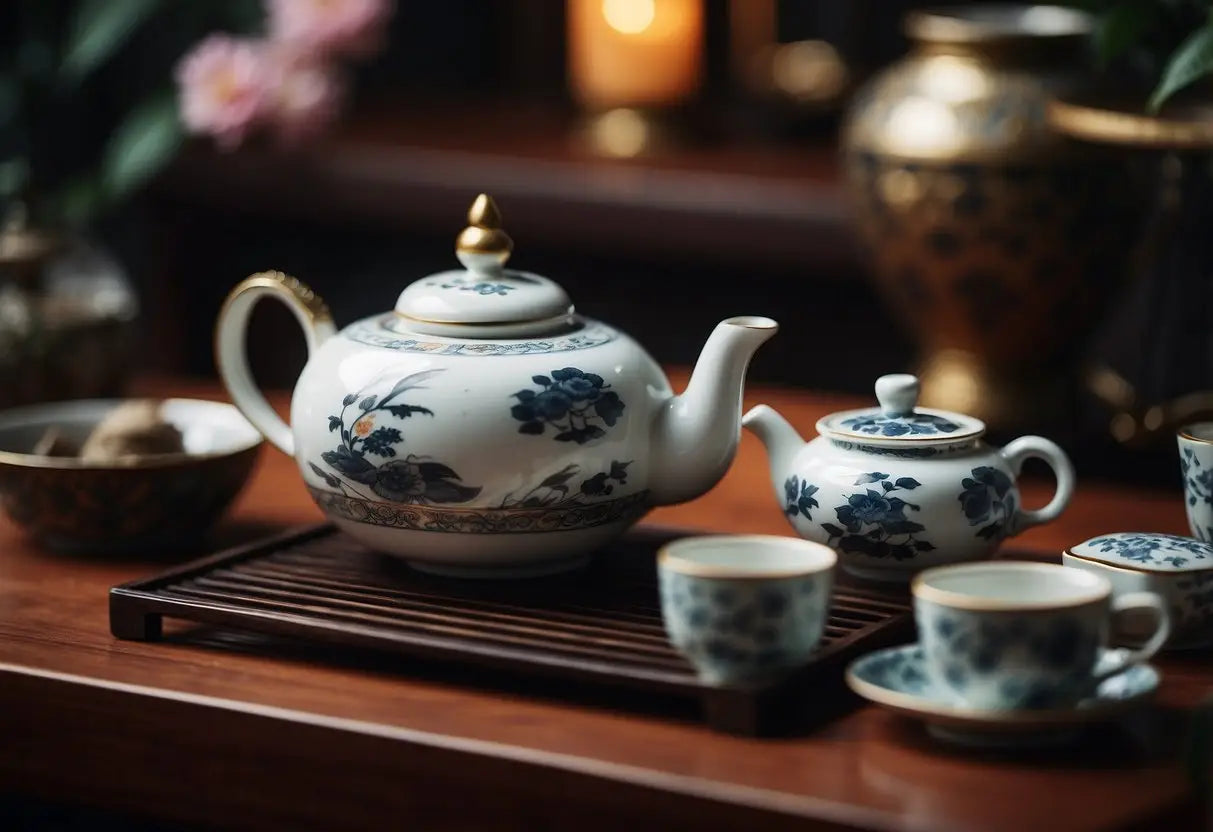
Chinese tea is deeply embedded in the culture and daily rituals of China. Tea ceremonies, such as the traditional Gongfu Cha, are performed with precision and grace. Each step, from warming the teapot to pouring the tea, reflects centuries of practice.
Intricate details matter. You might notice the use of Yixing clay teapots, prized for their ability to enhance the flavor of tea. These teapots are often used with oolong and pu-erh teas.
Social interaction plays a pivotal role. Sharing tea is a symbol of respect and friendship. You may see tea offered to guests as a sign of hospitality. In business settings, serving tea can symbolize the beginning of negotiations.
Tea appreciation clubs are common in China. Membership offers a way for you to deepen your knowledge and appreciation of various teas. Tastings and discussions become an educational journey into tea's rich history.
There's also a seasonal aspect. Different teas are favored throughout the year as certain types are believed to be more beneficial during specific seasons. For instance, cooling green teas might be preferred in summer.
In celebrations, tea is often included in festive activities. You might participate in tea rituals during weddings or holidays. It's a way of honoring both the past and present.
The meticulous preparation and consumption of Chinese tea showcase its cultural significance. Every sip connects you to a tradition that has been refined over centuries.
Nutritional Composition of Chinese Tea
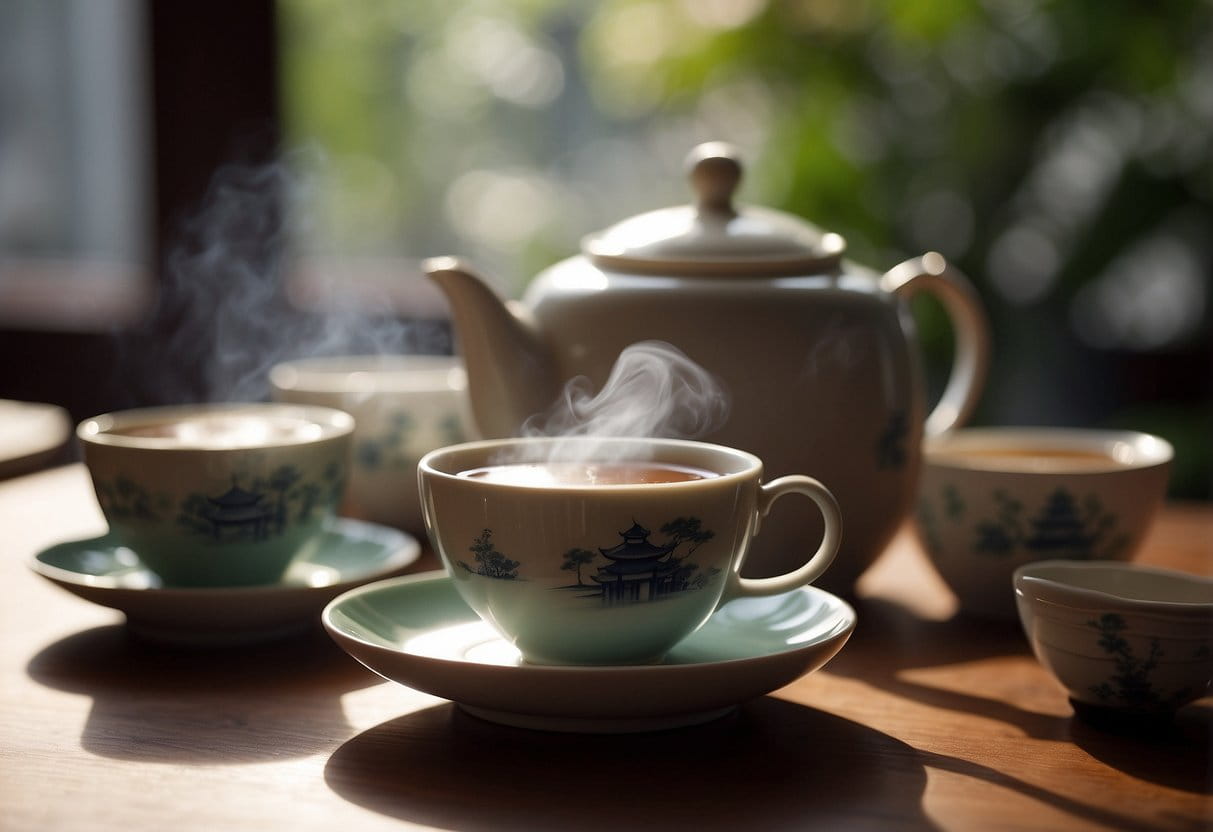
Chinese tea is known for its rich variety and significant health benefits.
Vitamins
Chinese tea is a good source of several essential vitamins:
- Vitamin C
- Vitamin E
- Vitamin K
Minerals
You'll also find a range of important minerals in Chinese tea:
- Magnesium
- Potassium
- Calcium
- Zinc
Antioxidants
Chinese tea is rich in antioxidants that protect your cells from damage:
- Catechins
- Polyphenols
- Flavonoids
Amino Acids
L-theanine, an amino acid found in Chinese tea, helps with relaxation and improves focus.
Calories and Macronutrients
Chinese tea is low in calories. When consumed without additives, it contains:
- 0 grams of fat
- 0 grams of protein
- Minimal carbohydrates
Caffeine Content
Chinese tea contains varying levels of caffeine depending on the type:
- Green tea: Moderate
- Black tea: High
- White tea: Low
Phenolic Compounds
These compounds contribute to the tea's flavor and health benefits:
- Tannins
- Theaflavins 国产
Scientific Research on Chinese Tea
Scientific studies indicate that Chinese tea offers multiple health benefits. Research highlights its potential in improving cardiovascular health.
Key Benefits:
- Antioxidant properties
- Supports heart health
- Promotes digestion
Studies found that Chinese green tea contains a high level of catechins, antioxidants that can help reduce inflammation. Black tea, rich in theaflavins, may lower cholesterol levels.
Notable Findings:
- Green tea antioxidants can reduce oxidative stress.
- Oolong tea may improve metabolism.
- Pu-erh tea has weight management effects.
Researchers have also noted Chinese tea's positive impact on mental health. Drinking it may enhance cognitive function and reduce stress.
In addition, a study published in a reputable journal showed that regular consumption might lower the risk of certain cancers. This includes esophageal and gastric cancers.
The amino acid L-theanine in Chinese tea is linked to improved focus and relaxation.
Common Components:
- Catechins: Found in green tea.
- Theaflavins: Present in black tea.
- L-theanine: Enhances mental clarity.
Health Metrics:
| Tea Type | Key Compound | Potential Benefit |
|---|---|---|
| Green Tea | Catechins | Antioxidant effects |
| Black Tea | Theaflavins | Improved heart health |
| Oolong Tea | Polyphenols | Metabolism boost |
| Pu-erh Tea | Micronutrients | Weight management |
These insights provide a clearer picture of how consuming Chinese tea might contribute to a healthier lifestyle.
Health Precautions and Potential Side Effects
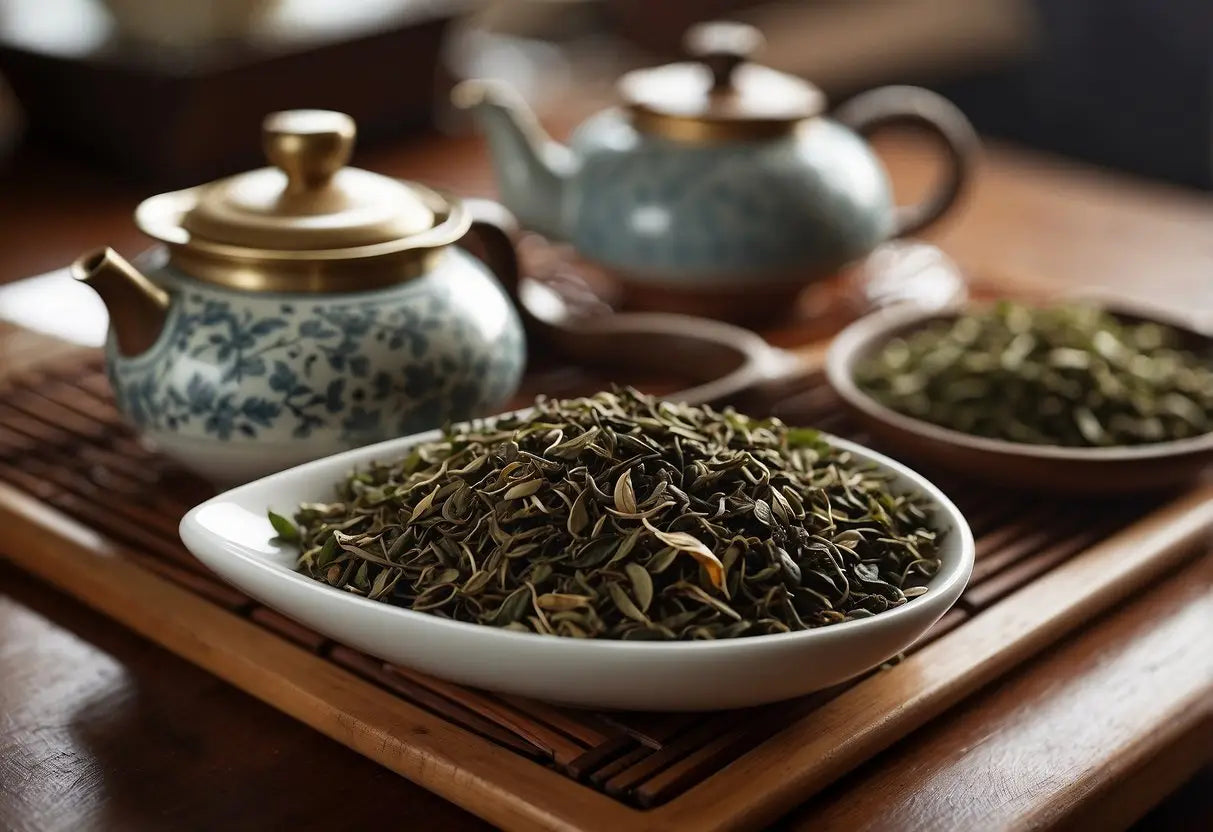
When drinking Chinese tea, be aware of potential side effects and health precautions.
Some people may experience caffeine sensitivity. This can lead to insomnia, jitteriness, or increased heart rate. It's essential to monitor how your body reacts and adjust your intake accordingly.
If you have iron deficiency, consuming large amounts of tea might impede iron absorption. It's recommended to drink tea between meals rather than with food to minimize this effect.
Stomach irritation can occur, especially if you drink tea on an empty stomach. To avoid discomfort, try to have tea after meals rather than before.
Some teas may contain trace amounts of heavy metals due to contaminated soil. Opt for trusted brands and sources to reduce the risk of exposure.
For those who are pregnant or nursing, consult your healthcare provider to determine safe consumption levels of Chinese tea.
Those taking medications should be cautious, as certain compounds in tea can interact with drugs, potentially affecting their efficacy. Always check with your doctor if you're on medication.
In rare cases, herbal teas may cause allergic reactions. If you notice any unusual symptoms, discontinue use and seek medical advice.
Lastly, dental health can be affected by frequent tea consumption, potentially leading to staining or enamel erosion. Regular dental hygiene practices are recommended to mitigate these effects.
Guidelines for Consuming Chinese Tea

When enjoying Chinese tea, you should be aware of a few guidelines to make the experience beneficial and enjoyable.
First, choose high-quality tea leaves. Look for whole leaves rather than broken ones. Whole leaves usually indicate better quality.
Pay attention to the water temperature. Green tea is best brewed at around 175°F (80°C), while black tea benefits from higher temperatures around 200°F (95°C).
Use the right amount of tea leaves. A general rule of thumb is to use about one teaspoon of tea leaves per cup of water. Adjust based on your taste preferences.
Here’s a quick reference:
| Tea Type | Water Temperature | Steep Time |
|---|---|---|
| Green Tea | 175°F (80°C) | 2-3 minutes |
| Black Tea | 200°F (95°C) | 3-5 minutes |
| Oolong Tea | 190-200°F (88-93°C) | 4-7 minutes |
| White Tea | 160-185°F (71-85°C) | 3-5 minutes |
Do not oversteep the tea. Oversteeping can result in a bitter taste. Follow the recommended steep times based on the type of tea you are brewing.
Stay mindful of your tea consumption. While Chinese tea offers many health benefits, drinking too much can cause side effects like insomnia due to caffeine. Limit intake to around 3-4 cups per day, especially if you are sensitive to caffeine.
Finally, store your tea properly. Keep it in a cool, dark place in an airtight container to maintain its freshness and flavor.
Comparison with Other Teas
When considering Chinese tea, green tea often comes to mind. Green tea is known for its high antioxidant content and potential health benefits. Compared to black tea, Chinese green tea is less oxidized, offering a lighter flavor and retaining more antioxidants.
Oolong tea is another popular Chinese tea. It falls between green and black tea in terms of oxidation. You might appreciate its balanced flavor, combining the freshness of green tea with the robustness of black tea.
Japanese green teas, such as matcha, offer a different experience. While Chinese green tea is typically brewed from leaves, matcha is powdered, allowing you to consume the whole leaf. This may provide more nutrients but also a distinctly stronger taste.
Herbal teas like chamomile or peppermint are caffeine-free and offer unique benefits. Unlike Chinese teas, they are not made from the Camellia sinensis plant. You may find them more soothing, especially in the evening, due to the absence of caffeine.
Finally, consider Indian chai tea, a blend of black tea, spices, and milk. This is quite different from traditional Chinese teas in both ingredients and preparation. The spices offer potential digestive benefits, while the milk adds creaminess and a smoother texture.
Using this diversity of teas, you can explore various flavors, benefits, and preparation methods. Each type offers unique characteristics that might appeal to your taste preferences and health goals.
← Older post Newer post →
